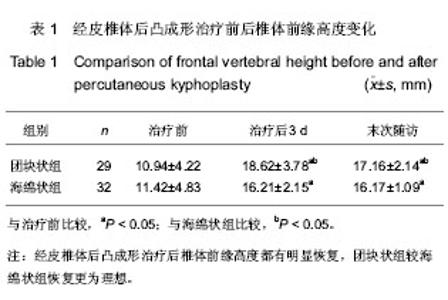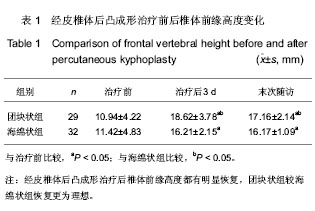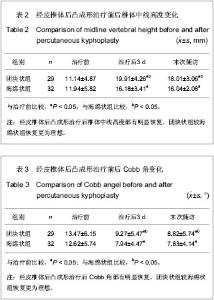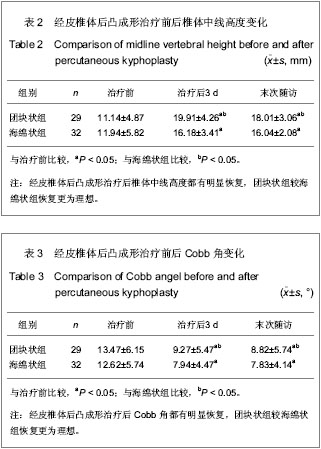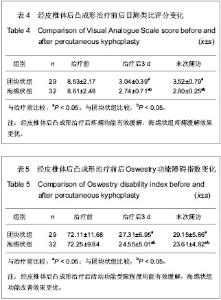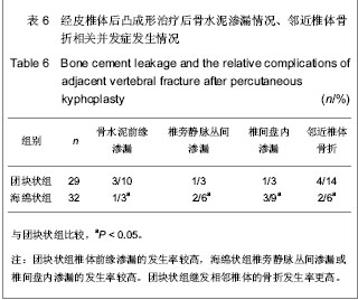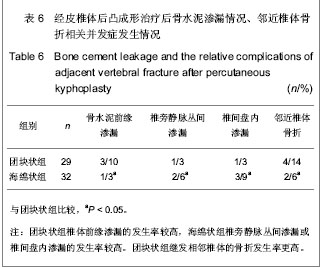Chinese Journal of Tissue Engineering Research
Previous Articles Next Articles
Bone cement distribution patterns of osteoporotic vertebral fractures with intravertebral clefts after vertebroplasty
Li Liang, Yu Xue-zhong, Sui Hai-tao, Ren Yue-bing, Liu Guang-quan
- Department of Orthopedics, Dongying People’s Hospital, Dongying 257091, Shandong Province, China
-
Received:2013-03-07Revised:2013-03-14Online:2013-06-25Published:2013-06-25 -
About author:Li Liang★, Master, Attending physician, Department of Orthopedics, Dongying People’s Hospital, Dongying 257091, Shandong Province, China jiawei20100303@163.com
CLC Number:
Cite this article
Li Liang, Yu Xue-zhong, Sui Hai-tao, Ren Yue-bing, Liu Guang-quan. Bone cement distribution patterns of osteoporotic vertebral fractures with intravertebral clefts after vertebroplasty[J]. Chinese Journal of Tissue Engineering Research, doi: 10.3969/j.issn.2095-4344.2013.26.006.
share this article
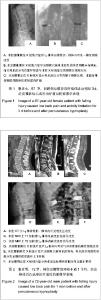
2.6 典型病例分析 患者女,67岁,因跌倒后腰背部疼痛伴活动受限 3 d,术前腰椎侧位X射线片显示L1椎体压缩骨折,椎体内可见一横行裂隙改变,见图1A。术后腰椎侧位X射线片显示该裂隙已被骨水泥呈团块状局限分布填充,而且骨水泥分布位置和形态与术前X射线显示的裂隙区域相对应,见图1B。术后腰椎正位X射线片显示骨水泥仅分布局限于裂隙区域,未能在椎体裂隙周围骨松质间隙内扩散,见图1C。 患者男,72岁,摔伤后腰背部疼痛不适1个月,术前CT示L2椎体骨折,椎体内可见透光区改变,见图2A。术前MRI上T1加权像L2椎体内病变呈低信号改变,见图2B。术前MRI上T2加权像L2椎体内病变呈高信号改变,见图2C。术前腰椎侧位X射线片显示L2椎体内可见气体密度影的横行裂隙改变,见图2D。术后腰椎侧位X射线片显示该裂隙已被骨水泥填充,骨水泥呈海绵状弥散分布至椎体的前缘和上下终板,见图2E。术后腰椎正位X射线片显示骨水泥呈海绵状弥散分布至整个椎体,见图2F。"
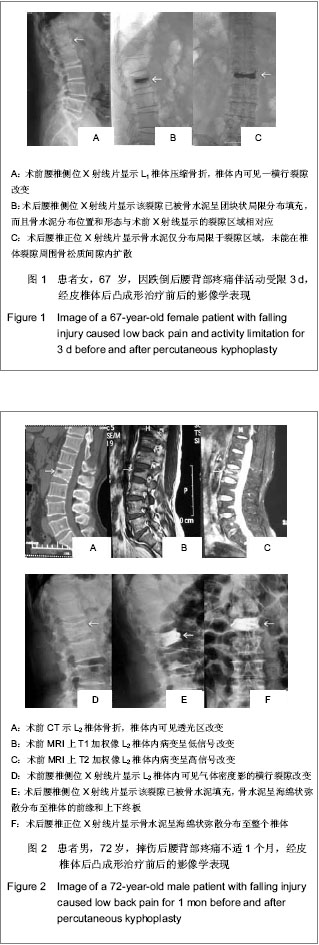
| [1] Kim YJ, Lee JW, Kim KJ, et al. Percutaneous vertebroplasty for intravertebral cleft: analysis of therapeutic effects and outcome predictors.Skeletal Radiol. 2010;39(8):757-766.[2] Maldague BE, Noel HM, Malghem JJ.The intravertebral vacuum cleft: a sign of ischemic vertebral collapse. Radiology. 1978;129(1):23-29.[3] Zhang ZD,Zhao HQ,Hao HT. Zhongguo Yixue Yingxiangxue Zazhi. 2009;17 (3):230-232.张子东,赵洪全,郝洪涛.推体缺血性压缩骨折的X线、CT及MRI表现[J].中国医学影像学杂志,2009,17(3):230-232. [4] Wu QX,Ni WF,Chi YL. Jizhu Waike Zazhi. 2012;10(1):56-59.吴爱悯,倪文飞,池永龙. 椎体内裂隙征的形成机理、影像学特征及手术治疗[J].脊柱外科杂志,2012,10(1):56-59.[5] Libicher M, Appelt A, Berger I,et al.The intravertebral vacuum phenomen as specific sign of osteonecrosis in vertebral compression fractures: results from a radiological and histological study.Eur Radiol. 2007;17(9):2248-2252. [6] Maldague BE, Noel HM, Malghem JJ.The intravertebral vacuum cleft: a sign of ischemic vertebral collapse. Radiology. 1978;129(1):23-29.[7] Freedman BA, Heller JG. Kummel disease: a not-so-rare complication of osteoporotic vertebral compression fractures. J Am Board Fam Med. 2009;22(1):75-78.[8] Kaneda K, Asano S, Hashimoto T,et al. The treatment of osteoporotic-posttraumatic vertebral collapse using the Kaneda device and a bioactive ceramic vertebral prosthesis.Spine (Phila Pa 1976). 1992;17(8 Suppl): S295-303.[9] Galibert P, Deramond H, Rosat P, et al. Preliminary note on the treatment of vertebral angioma by percutaneous acrylic vertebroplasty.Neurochirurgie. 1987;33(2):166-168.[10] Jang JS, Kim DY, Lee SH. Efficacy of percutaneous vertebroplasty in the treatment of intravertebral pseudarthrosis associated with noninfected avascular necrosis of the vertebral body. Spine (Phila Pa 1976). 2003; 28(14):1588-1592.[11] Grohs JG, Matzner M, Trieb K,et al.Treatment of intravertebral pseudarthroses by balloon kyphoplasty. J Spinal Disord Tech. 2006;19(8):560-565.[12] Mathis JM. Percutaneous vertebroplasty: complication avoidance and technique optimization. AJNR Am J Neuroradiol. 2003;24(8):1697-1706.[13] Kaneda K, Asano S, Hashimoto T,et al. The treatment of osteoporotic-posttraumatic vertebral collapse using the Kaneda device and a bioactive ceramic vertebral prosthesis.Spine (Phila Pa 1976). 1992 ;17(8 Suppl):S295-303.[14] Krauss M, Hirschfelder H, Tomandl B,et al. Kyphosis reduction and the rate of cement leaks after vertebroplasty of intravertebral clefts. Eur Radiol. 2006;16(5):1015-1021.[15] Baroud G, Vant C, Giannitsios D, et al. Effect of vertebral shell on injection pressure and intravertebral pressure in vertebroplasty.Spine (Phila Pa 1976). 2005;30(1):68-74.[16] Chen LH, Lai PL, Chen WJ.Unipedicle percutaneous vertebroplasty for spinal intraosseous vacuum cleft. Clin Orthop Relat Res. 2005;(435):148-153.[17] Lane JI, Maus TP, Wald JT,et al. Intravertebral clefts opacified during vertebroplasty: pathogenesis, technical implications, and prognostic significance. AJNR Am J Neuroradiol. 2002; 23(10):1642-1646.[18] Jang JS, Kim DY, Lee SH. Efficacy of percutaneous vertebroplasty in the treatment of intravertebral pseudarthrosis associated with noninfected avascular necrosis of the vertebral body.Spine (Phila Pa 1976). 2003;28(14):1588-1592.[19] Trout AT, Kallmes DF, Lane JI,et al. Subsequent vertebral fractures after vertebroplasty: association with intraosseous clefts. AJNR Am J Neuroradiol. 2006;27(7):1586-1591.[20] Wiggins MC, Sehizadeh M, Pilgram TK,et al. Importance of intravertebral fracture clefts in vertebroplasty outcome. AJR Am J Roentgenol. 2007;188(3):634-640.[21] Mousavi P, Roth S, Finkelstein J,et al. Volumetric quantification of cement leakage following percutaneous vertebroplasty in metastatic and osteoporotic vertebrae. J Neurosurg. 2003;99(1 Suppl):56-59. [22] Meng ZB,Li J,Fu K,et al. Shengwu Guke Cailiao yu Linchuang Yanjiu. 2012;9(2):1-4.孟志斌,李俊,付昆,等. PKP 技术治疗骨质疏松性椎体骨折不愈合的临床观察[J].生物骨科材料与临床研究,2012,9(2):1-4.[23] Grohs JG, Matzner M, Trieb K,et al.Treatment of intravertebral pseudarthroses by balloon kyphoplasty. J Spinal Disord Tech. 2006;19(8):560-565.[24] Wiggins MC, Sehizadeh M, Pilgram TK,et al. Importance of intravertebral fracture clefts in vertebroplasty outcome. AJR Am J Roentgenol. 2007;188(3):634-640.[25] Kaufmann TJ, Trout AT, Kallmes DF.The effects of cement volume on clinical outcomes of percutaneous vertebroplasty. AJNR Am J Neuroradiol. 2006;27(9):1933-1937.[26] Liang D,Jiang XB,Yao ZS,et al. Zhongguo Jizhu Jisui Zazhi. 2010;20(3):260-261.粱德,江晓兵,姚珍松,等. 过伸体位下椎体成形术治疗Kümmell病的近期疗效[J].中国脊柱脊髓杂志,2010,20(3): 260-261.[27] Libicher M, Appelt A, Berger I,et al.The intravertebral vacuum phenomen as specific sign of osteonecrosis in vertebral compression fractures: results from a radiological and histological study. Eur Radiol. 2007;17(9):2248-2252.[28] Huang WG,Yi JF,Bai RF,et al. Zhongguo Zuzhi Gongcheng Yanjiu yu Linchuang Kangfu. 2011;15(30):5669-5674.黄卫国,易军飞,白瑞飞,等.椎体成形穿刺注射骨水泥防止灾难性并发症:87例137个椎体资料分析[J].中国组织工程研究与临床康复,2011,15(30):5669-5674.[29] Li DG,Su PJ,Chen GF,et al. Zhongguo Zuzhi Gongcheng Yanjiu. 2012;16(4):713-716.李大刚,苏培基,陈敢峰,等. 椎体成形和椎体后凸成形治疗骨质疏松性椎体压缩骨折的Meta分析[J].中国组织工程研究,2012, 16(4):713-716.[30] Trout AT, Kallmes DF, Lane JI,et al. Subsequent vertebral fractures after vertebroplasty: association with intraosseous clefts. AJNR Am J Neuroradiol. 2006;27(7):1586-1591.[31] Pflugmacher R, Schroeder RJ, Klostermann CK. Incidence of adjacent vertebral fractures in patients treated with balloon kyphoplasty: two years' prospective follow-up. Acta Radiol. 2006;47(8):830-840.[32] Tohmeh AG, Mathis JM, Fenton DC,et al. Biomechanical efficacy of unipedicular versus bipedicular vertebroplasty for the management of osteoporotic compression fractures.Spine (Phila Pa 1976). 1999;24(17):1772-1776.[33] Wang LS,Lv SQ,Tan JW,et al. Zhongguo Weichuang Waike Zazhi. 2011;11(4):338-341.王磊升,吕世桥,谭江威,等. 单侧经皮椎体后凸成形术治疗有“真空裂隙征”的骨质疏松椎体骨折[J].中国微创外科杂志,2011, 11(4):338-341.[34] Liebschner MA, Rosenberg WS, Keaveny TM. Effects of bone cement volume and distribution on vertebral stiffness after vertebroplasty. Spine (Phila Pa 1976). 2001;26(14):1547- 1554. |
| [1] | Liu Zhengpeng, Wang Yahui, Zhang Yilong, Ming Ying, Sun Zhijie, Sun He. Application of 3D printed interbody fusion cage for cervical spondylosis of spinal cord type: half-year follow-up of recovery of cervical curvature and intervertebral height [J]. Chinese Journal of Tissue Engineering Research, 2021, 25(6): 849-853. |
| [2] | Feng Guancheng, Fang Jianming, Lü Haoran, Zhang Dongsheng, Wei Jiadong, Yu Bingbing. How does bone cement dispersion affect the early outcome of percutaneous vertebroplasty [J]. Chinese Journal of Tissue Engineering Research, 2021, 25(22): 3450-3457. |
| [3] | Sun Yiqiang, Xing Jianqiang, Li Xuecheng, Wang Xin, Tian Shenglan, Zhao Zihao, Geng Xiaopeng. Kyphoplasty versus vertebroplasty in the treatment of osteoporotic vertebral compression fracture in the elderly: a comparison of vertebral height recovery [J]. Chinese Journal of Tissue Engineering Research, 2021, 25(18): 2851-2855. |
| [4] | Zhang Le, Pan Bin, Ruan Ruxin, Guo Kaijin. Effect of lumbopelvic sagittal parameters on secondary adjacent vertebral fracture after percutaneous kyphoplasty for osteoporotic vertebral compression fracture [J]. Chinese Journal of Tissue Engineering Research, 2021, 25(15): 2370-2374. |
| [5] | Jing Wanli, Zhang Tao, Teng Donghui, Shi Tao, Zhou Qiang. Poor outcomes of bone filling mesh container vertebroplasty for the treatment of osteoporotic vertebral compression fractures with vertebral body wall incompetence [J]. Chinese Journal of Tissue Engineering Research, 2021, 25(10): 1522-1527. |
| [6] | Liu Qun, Sun Dongdong, Gao Lilan, He Zhijiang, Sun Minglin. Risk factors for fractures secondary to percutaneous kyphoplasty: a meta-analysis [J]. Chinese Journal of Tissue Engineering Research, 2020, 24(6): 976-984. |
| [7] | Li Kaiming, Wang Shangquan, Li Linghui, Zhu Liguo, Zhang Qing, Xie Rui. Bone filling bag vertebroplasty and percutaneous kyphoplasty for the treatment of thoracolumbar osteoporotic compression fractures: a meta-analysis of improving Cobb angle and reducing bone cement leakage [J]. Chinese Journal of Tissue Engineering Research, 2020, 24(4): 650-656. |
| [8] | Liu Ruizhen, Wang Wangren, Hao Chen, Liang Dongmu, Guan Haishan. Effect of bone cement distribution on adjacent vertebral body fracture after unilateral percutaneous vertebroplasty for single segment osteoporotic vertebral compression fracture [J]. Chinese Journal of Tissue Engineering Research, 2020, 24(28): 4498-4504. |
| [9] | Xie Hui, Chen Haopeng, Wang Benjie, Fu Weimin, Zhao Dewei. Effect of different distribution types of bone cement after percutaneous kyphoplasty on osteoporotic vertebral compression fractures at different sites [J]. Chinese Journal of Tissue Engineering Research, 2020, 24(28): 4505-4510. |
| [10] | Li Kaiming, Zhu Liguo, Zhang Qing, Li Linghui, Xie Rui, Chen Ming, Liang Long, Lin Chengyu, Hou Xiaozhou. Zolidronic acid combined with percutaneous kyphoplasty in the treatment of osteoporotic compression fractures: a meta-analysis of bone density improvement, recurrent vertebral fractures prevention, and long-term efficacy evaluation [J]. Chinese Journal of Tissue Engineering Research, 2020, 24(24): 3911-3917. |
| [11] | Luo Wei, Chen Jianping, Sun Qianqian, Chen Chen, Li Hang, Ma Chenglong, Su Rui, Feng Xiaoyue, Sun Yurui. Facet joint injection versus percutaneous kyphoplasty for mild vertebral fragility fractures: rapid analgesia and restoration of spinal stability [J]. Chinese Journal of Tissue Engineering Research, 2020, 24(20): 3168-3173. |
| [12] | Ren Yide, Zhang Yafeng, Li Feng, Gao Hongwen. Relationship between unilateral percutaneous kyphoplasty for treating Kummell’s disease and the amount of injected bone cement [J]. Chinese Journal of Tissue Engineering Research, 2020, 24(16): 2467-2472. |
| [13] |
Wang Mengran, Fu Zhiyi, Wang Huidong, Wu Yujie.
Efficacy and complications of different viscosities of high-dose
bone cement applied in percutaneous vertebroplasty |
| [14] | Huang Tianji, Yang Shengdong, Lin Hao, Zhang Chunyang, Deng Zhongqi, Zhong Weiyang, Luo Xiaoji. Mapping knowledge domains of bibliometrics regarding percutaneous vertebroplasty and percutaneous kyphoplasty based on VOSviewer [J]. Chinese Journal of Tissue Engineering Research, 2020, 24(15): 2410-2417. |
| [15] | Wu Bin, Bai Fenghua, Lin Mingxia, Lin Jianping. Risk factors of adjacent vertebral collapse after kyphoplasty with cement injection in older adult women [J]. Chinese Journal of Tissue Engineering Research, 2020, 24(12): 1829-1834. |
| Viewed | ||||||
|
Full text |
|
|||||
|
Abstract |
|
|||||
